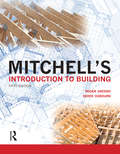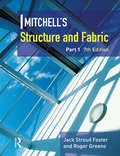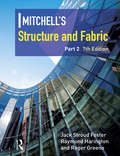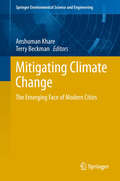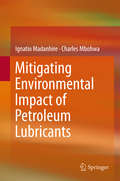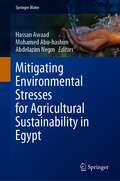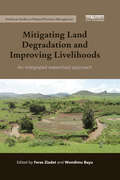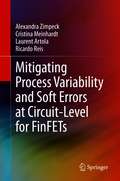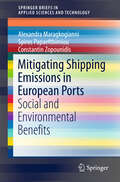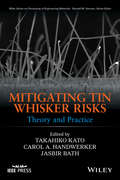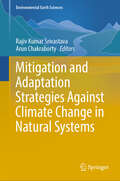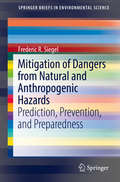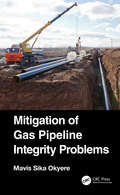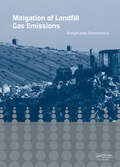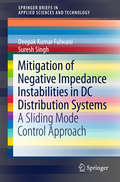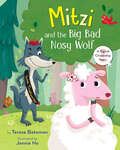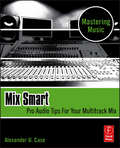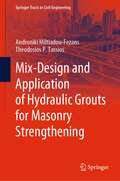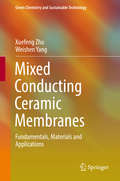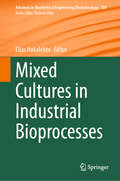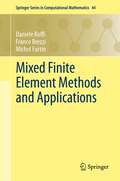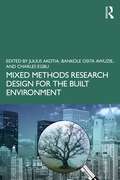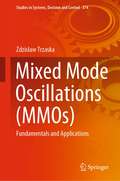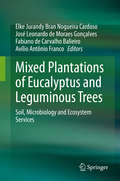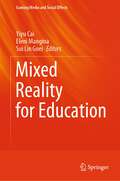- Table View
- List View
Mitchell's Introduction to Building (Mitchell's Building Series)
by Roger GreenoIntroduction to Building provides a comprehensive introduction to various aspects of development and associated building procedures, from initial planning and design through procurement of building work, contractual arrangements and construction techniques. Now in its Fifth Edition, this popular text continues to present an authoritative overview of the many design and practical considerations associated with the creation and maintenance of modern buildings, including repair of existing buildings and traditional construction procedures. Topics covered include the functional requirements of a building: appearance, durability, dimensional suitability, strength and stability, weather exclusion, sound control, thermal comfort, fire protection, lighting and ventilating, sanitation and drainage, security, cost, sustainability, building processes, the building team, communication and construction methods.
Mitchell's Structure & Fabric Part 1
by J S FosterA new edition of the best selling title in the prestigious Mitchell's Building Series. This book is the first of a two volume set which provides a complete and thorough treatment of the principles and techniques used in the design and construction of a building. This new edition has been thoroughly updated to bring it into line with recent changes in British Standards and developments in construction techniques while retaining the comprehensive approach for which it is renowned.
Mitchell's Structure & Fabric Part 2 (Mitchell's Building Series)
by J S FosterStructure and Fabric Part 2 consolidates and develops the construction principles introduced in Part 1. With generous use of illustrations this book provides a thorough treatment of the techniques used in the construction of various types of building.This new edition has been thoroughly reviewed and updated with reference to recent changes in building regulations, national and European standards and related research papers. The comprehensive presentation provides guidance on established and current practice, including the administrative procedures necessary for the construction of buildings.
Mitigating Climate Change: The Emerging Face of Modern Cities
by Anshuman Khare Terry BeckmanWith ever increasing trends in urban consumption and production practices, a call for action to mitigate Climate Change is often seen as a way to foster sustainable development. Considerable attention is now being paid to determine what urban sustainability would include. Today there is a pressing need to broaden our knowledge and apply new concepts and frameworks to development of modern cities. Building on the foregoing, this book attempts to bring together and discuss concepts, tools, frameworks and best practices to cope with the emerging challenges faced by cities today. The book will be of use to policy makers, city planners, practitioners and academics who are starting to project what modern cities would need to do in terms of energy efficiency, mobility, planning and design of habitat and infrastructure and adapting to climate change.
Mitigating Environmental Impact of Petroleum Lubricants
by Ignatio Madanhire Charles MbohwaThis book explores effective environmental impact mitigation for petroleum-based lubricants to reduce their negative persistence during usage and upon end-of-life disposal. The book reviews the basic tribology of lubricants as well as initiatives that may enhance the environmental and economic effectiveness of lubricating oils from the composition design perspective across industries. Considering the blending, application, and disposal of petroleum lubricants in a holistic manner, the book presents and extends current best practices that minimize or eliminate adverse environmental impact throughout the product's life cycle. The book reviews methods including: raw material substitution, minimizing oil losses during and after manufacturing, raw material and energy consumption reduction, and environmentally friendly applications of oil disposal as ways forward for cleaner and more effective production. This book provides readers with strategies for incorporating cleaner production practices into their operations - a benefit to both environmental legal compliance and business competitiveness - all the while preserving the environment for sustainable development. The book is therefore of interest to both manufacturers and consumers in the lubricants industry.
Mitigating Environmental Stresses for Agricultural Sustainability in Egypt (Springer Water)
by Mohamed Abu-Hashim Hassan Awaad Abdelazim NegmThis book focuses on the soil and environmental resources and how to utilize them under Egyptian conditions to achieve tolerance to environmental abiotic stresses, i.e., drought, heat, salt, pollutants, and biotic stresses such as disease resistance. Further, it explores ways to increase productivity, improve the quality of field crops, and reduce the food gap. The application of modern technologies is an essential mechanism for improving crops' productivity through laser, seed technology, mycorrhiza, and biotechnology to enhance the yield of genotypes in sustainable farming systems. Therefore, this book discusses fundamental ways to increase productivity under various environmental circumstances. The book reflects the enormous potential held by horizontal expansion in the newly reclaimed lands in Egypt. Tapping that potential depends on developing crops that are highly tolerant to environmental stresses and mitigating the impacts of climate changes around the world to help Egypt and countries with similar weather and water deficits achieve the 2030 sustainability agenda for agriculture. Given its profundity and scope, the book offers a valuable asset for stakeholders, policy planners, decision-makers, researchers, and scientists in Egypt and worldwide.
Mitigating Land Degradation and Improving Livelihoods: An Integrated Watershed Approach (Earthscan Studies in Natural Resource Management)
by Feras ZiadatThe research presented in this book demonstrates how an integrated ‘systems’ approach to farming in the watershed context increases the effectiveness of a production system and improves people’s livelihoods. It takes an integrated approach, using one watershed in Ethiopia as a ‘laboratory’ or model case study to focus on the interaction and interdependence between land, water, crops, soil, water harvesting, supplemental irrigation, forestry, socio-economic aspects, livestock and farm tools. A range of linked studies was conducted with active participation of the farming community and other relevant stakeholders, such as the local offices of agriculture and extension services. The starting point for the work was the premise that previous efforts to solve farming system constraints using a piecemeal approach or discipline-specific focus have not been successful. Thus, addressing agricultural and environmental constraints through a holistic approach enables the generation of comprehensive technologies to sustainably improve the natural resource base and livelihoods of communities. The authors discuss trade-offs and resource allocation, demonstrating how the environment can be protected while also improving productivity. A unique feature is the methodology developed for the selection of suitable fields and farmers to implement new approaches or improved technologies, to achieve production increases while reducing degradation of sensitive agro-ecosystems. It is also shown how the watershed scale is a valuable basis for assessing the protection of fragile lands.
Mitigating Process Variability and Soft Errors at Circuit-Level for FinFETs
by Ricardo Reis Alexandra Zimpeck Cristina Meinhardt Laurent ArtolaThis book evaluates the influence of process variations (e.g. work-function fluctuations) and radiation-induced soft errors in a set of logic cells using FinFET technology, considering the 7nm technological node as a case study. Moreover, for accurate soft error estimation, the authors adopt a radiation event generator tool (MUSCA SEP3), which deals both with layout features and electrical properties of devices. The authors also explore four circuit-level techniques (e.g. transistor reordering, decoupling cells, Schmitt Trigger, and sleep transistor) as alternatives to attenuate the unwanted effects on FinFET logic cells. This book also evaluates the mitigation tendency when different levels of process variation, transistor sizing, and radiation particle characteristics are applied in the design. An overall comparison of all methods addressed by this work is provided allowing to trace a trade-off between the reliability gains and the design penalties of each approach regarding the area, performance, power consumption, single event transient (SET) pulse width, and SET cross-section.
Mitigating Shipping Emissions in European Ports: Social and Environmental Benefits (SpringerBriefs in Applied Sciences and Technology)
by Constantin Zopounidis Alexandra Maragkogianni Spiros PapaefthimiouThe book quantifies the impact of in-port ships’ greenhouse gas emissions and air pollution in adjacent cities, and evaluates the feasibility of implementing shore-side electricity facilities in Europe to reduce the unwanted social and environmental effects of ships at berth. The book also discusses the potential of future “green” ports and the use of shore side electricity as a means of achieving them. Individual chapters focus on the economic and social costs of in-port ships’ emissions by illustrating current environmental policies to mitigate air emissions and the available abatement measures for in-port emissions. It also discusses the external cost of vessel emissions in ports as well as the impacts on air quality and human health. Examining the expected barriers to the implementation of shore- side electricity facilities, it proposes policies to accelerate the implementation of relevant mitigation measures.
Mitigating Tin Whisker Risks: Theory and Practice
by Jasbir Bath Carol A. Handwerker Takahiko KatoDiscusses the growth mechanisms of tin whiskers and the effective mitigation strategies necessary to reduce whisker growth risks This book covers key tin whisker topics, ranging from fundamental science to practical mitigation strategies. The text begins with a review of the characteristic properties of local microstructures around whisker and hillock grains to identify why these particular grains and locations become predisposed to forming whiskers and hillocks. The book discusses the basic properties of tin-based alloy finishes and the effects of various alloying elements on whisker formation, with a focus on potential mechanisms for whisker suppression or enhancement for each element. Tin whisker risk mitigation strategies for each tier of the supply chain for high reliability electronic systems are also described. Discusses whisker formation factors including surface grain geometry, crystallographic orientation-dependent surface grain boundary structure, and the localization of elastic strain/strain energy density distribution Examines how whiskers and hillocks evolve in time through real-time studies of whisker growth with the scanning electron microscope/focused ion beaming milling (SEM/FIB) Covers characterization methods of tin and tin-based alloy finishes such as transmission electron microscopy (TEM), scanning electron microscopy (SEM), and electron backscatter diffraction (EBSD) Reviews theories of mechanically-induced tin whiskers with case studies using pure tin and other lead-free finishes shown to evaluate the pressure-induced tin whiskers Mitigating Tin Whisker Risks: Theory and Practice is intended for the broader electronic packaging and manufacturing community including: manufacturing engineers, packaging development engineers, as well as engineers and researchers in high reliability industries.
Mitigation and Adaptation Strategies Against Climate Change in Natural Systems (Environmental Earth Sciences)
by Rajiv Kumar Srivastava Arun ChakrabortyThis book addresses strategies for mitigating and adapting to climate change in natural systems. According to the IPCC (2021) report, human-induced climate change has widespread global effects, significantly impacting natural ecosystems. Extreme weather events linked to climate change harm terrestrial, freshwater, ocean, and coastal ecosystems, reduce food security, displace populations, damage livelihoods, health, and security, and exacerbate inequality. While the impacts of climate change are vast and varied, making it impossible to cover every sector, the authors have aimed to address key areas and offer strategies for combating climate change through mitigation and adaptation. The book is structured into five sections: • Land (agriculture, horticulture, soil, forest) • Water (rivers, lakes) • Atmosphere (hydrology, climate) • Technologies/Approaches (remote sensing, GIS, AI tools, ChatGPT) • Case Studies (crops, forests, soil glomalin application, eco-friendly fertilizers), with a focus on modelling approaches to assess these strategies. Additionally, the authors reviewed related works on climate change mitigation and adaptation, identifying a gap in using newer technologies and approaches. The book also covers topics such as water quality and the analysis of several greenhouse gases such ad NO2, O3, CO2 and CH4 in the environment. This book will be beneficial for students, educators, professionals, researchers, policymakers, and farmers. It provides content ranging from introductory to advanced levels, making it accessible to those working in environmental science.
Mitigation of Dangers from Natural and Anthropogenic Hazards
by Frederic R. R. SiegelThis book advances a three-step program for mitigation of natural and anthropogenic hazards, addressing mitigation economics and funding possibilities to meet the needs of at risk countries that lack the financial resources to invest in disaster reduction programs. Within the context of mitigation, this book covers prediction-prevention-preparedness for global warming/climate change as existing and progressive processes that create or abet slow developing or rapidly occurring hazards that endanger society such as sea level rise, extreme weather events, threats to food/water security, and the spread of infectious diseases.
Mitigation of Gas Pipeline Integrity Problems
by Mavis Sika OkyereMitigation of Gas Pipeline Integrity Problems presents the methodology to enable engineers, experienced or not, to alleviate pipeline integrity problems during operation. It explains the principal considerations and establishes a common approach in tackling technical challenges that may arise during gas production. Covers third-party damage, corrosion, geotechnical hazards, stress corrosion cracking, off-spec sales gas, improper design or material selection, as-built flaws, improper operations, and leak and break detection Details various hazard mitigation options Offers tested concepts of pipeline integrity blended with recent research results, documented in a scholarly fashion to make it simple to the average reader This practical work serves the needs of advanced students, researchers, and professionals working in pipeline engineering and petrochemical industries.
Mitigation of Landfill Gas Emissions
by Malgorzata PawlowskaLandfilling has been and still remains an important means of municipal solid waste management but it poses a threat to the purity of the environment, especially air. In the coming years, a radical decline in the share of landfilling in waste disposal practices should not be expected. However, this is not to say that people are powerless in the face
Mitigation of Negative Impedance Instabilities in DC Distribution Systems
by Deepak Kumar Fulwani Suresh SinghThis book focuses on the mitigation of the destabilizing effects introduced by constant power loads (CPLs) in various non-isolated DC/DC converters and island DC microgrids using a robust non-linear sliding mode control (SMC) approach. This book validates theoretical concepts using real-time simulation studies and hardware implementations. Novel sliding mode controllers are proposed to mitigate negative impedance instabilities in DC/DC boost, buck, buck-boost, bidirectional buck-boost converters, and islanded DC microgrids. In each case, the condition for the large-signal stability of the converter feeding a CPL is established. An SMC-based nonlinear control scheme for an islanded DC microgrid feeding CPL dominated load is proposed so as to mitigate the destabilizing effect of CPL and to ensure system stability under various operating conditions. A limit on CPL power is also established to ensure system stability. For all proposed solutions, simulation studies and hardware implementations are provided to validate the effectiveness of the proposed sliding mode controllers.
Mitzi and the Big Bad Nosy Wolf: A Digital Citizenship Story
by Teresa BatemanA clever lamb outsmarts a nosy wolf in this humorous fable about online safety for young children.When a furry stranger named Rolf starts asking Mitzi questions about her name, where she lives, where her mom and dad work, and more, Mitzi quickly devises a strategy to dispatch the nosy wolf using her dance skills!A refrain of &“That&’s Private!&” teaches kids the importance of privacy when it comes to sharing personal information while hilarious visual gags keep the reading experience light. Author Teresa Bateman created Mitzi when she was a school librarian as a way to talk with her students about the dos and don'ts of online safety. Perfect for teaching children how to use the internet in a safe, respectful manner, Mitzi and the Big Bad Nosy Wolf is just the book for today's young digital citizens.Back matter includes Mitzi&’s Rules for Digital Citizenship, which outlines best practices when using the internet, from safety to cyberbullying; a glossary that include such terms as public, private, and digital footprint; and a memory game activity for at home or classroom use.
Mix Smart: professional techniques for the home studio
by Alex CaseAfter you've recorded the perfect song, you're only halfway there! Mixing is where the magic really happens and getting the perfect mix is a challenge. One of the most elusive arts of the recording practice, mixing can take a lifetime to master - this handbook jump-starts your skills and fast-forwards your progress! Breaking the mix down by different effects - EQ, distortion, compression, expansion, pitch shift, delay, reverb, and more - and applying them to some of the most important instruments in pop music, Mix Smart will arm you with the skills and techniques you need to tap into your musicality and express it through multitrack mixing, putting true professional quality mixing within your reach. *Future proof, ear-opening strategies will empower your inner-musician, giving you the knowledge you need to develop your mixing skills - from basic to advanced*Breaking the mix down by different effects, with detailed strategies for the most important pop instruments showing you how to create the perfect combination*Bonus Website, www.recordingology.com, packed with samples and example tracks, so you can practice as you learn*Mix Smart Quick Start summaries at the end of each chapter get you to work faster*Demystifies the technical, making the tools of the mix rig accessible - analog and digital, outboard and in the box, stereo and surround*For everyone who mixes - studio, live, music, film, games, and broadcast The recording studio is your musical instrument, and it's time you really learned how to play. Alex Case shows you not just how to mix well, but how to Mix Smart!
Mix-Design and Application of Hydraulic Grouts for Masonry Strengthening (Springer Tracts in Civil Engineering)
by Androniki Miltiadou-Fezans Theodosios P. TassiosThis book provides guidance for the rational design and application of hydraulic grouts, based on a series of specific data (type of masonry, voids' width, targeted strength and durability level, available materials, etc.). To this end, the basic characteristics of a grout, i.e. its injectability (penetrability, fluidity and stability), its strength and durability, are taken into account by means of rational models and quantified expressions of all grout-design parameters. Thus, a holistic, rational mix design methodology for optimization of grout composition is given, permitting the preliminary design of grouts, without having to resort to multiple tests in advance. Moreover, detailed practical guidelines for grouting application and quality control, based on real case studies, are also included. The book attempts to rationalize the entire procedure of this poly-parametric decision-making, keeping however in mind the need for practical engineering solutions.
Mixed Conducting Ceramic Membranes
by Xuefeng Zhu Weishen YangThis book is intended to bring together into a single book all aspects of mixed conducting ceramic membranes. It provides a comprehensive description of the fundamentals of mixed ionic-electronic conducting (MIEC) membranes from the basic theories and materials to fabrication and characterization technologies. It also covers the potential applications of MIEC membrane technology in industry. This book offers a valuable resource for all scientists and engineers involved in R&D on mixed conducting ceramic membrane technology, as well as other readers who are interested in catalysis in membrane reactor, solid state electrochemistry, solid oxide fuel cells, and related topics. Xuefeng Zhu, PhD, is a Professor at State Key Laboratory of Catalysis, Dalian Institute of Chemical Physics, Chinese Academy of Sciences, China. Weishen Yang, PhD, is the team leader for Membrane Catalysis and New Catalytic Materials and a DICP Chair Professor at State Key Laboratory of Catalysis, Dalian Institute of Chemical Physics, Chinese Academy of Sciences, China.
Mixed Cultures in Industrial Bioprocesses (Advances in Biochemical Engineering/Biotechnology #189)
by Elias HakalehtoThis book reviews the potential of mixed microbial cultures in industrial bioprocesses, offering groundbreaking insights and practical applications. It addresses different applications and challenges and discusses potential solutions for utilizing mixed cultures. Through this book, readers will learn about the latest advancements in microbial bioprocessing, from innovative fermentation techniques to sustainable waste management solutions. Divided into 10 chapters, the book covers topics such as mixed strain fermentation and metabolomics, and the dynamic nature of the human gut microbiota. Expert contributors also explore critical issues like selenium removal from wastewater, simultaneous CO2 absorption and wastewater treatment, and the production of novel energy gases using undefined mixed cultures. This book highlights the power and benefits of microbial communities and their metabolic networks by describing how they can be harnessed for food and forest industry waste reuse and the upgrading of products from bio-refinery pilots. The combinations of economically feasible and sustainable processes in ecosystem engineering are also discussed. Finally, the future of biorefinery industries as a part of circulation economies and healthier environments is discussed. Given its breadth, the book is a valuable resource for researchers in biochemical engineering and biotechnology fields, as well as anyone dealing with industrial R&D, construction projects or sustainable food and feed production. The empirical research and its outcomes presented here address pressing environmental challenges, making this volume a must-read for anyone committed to advancing sustainable biotechnological solutions.
Mixed Finite Element Methods and Applications
by Franco Brezzi Daniele Boffi Michel FortinNon-standard finite element methods, in particular mixed methods, are central to many applications. In this text the authors, Boffi, Brezzi and Fortin present a general framework, starting with a finite dimensional presentation, then moving on to formulation in Hilbert spaces and finally considering approximations, including stabilized methods and eigenvalue problems. This book also provides an introduction to standard finite element approximations, followed by the construction of elements for the approximation of mixed formulations in H(div) and H(curl). The general theory is applied to some classical examples: Dirichlet's problem, Stokes' problem, plate problems, elasticity and electromagnetism.
Mixed Methods Research Design for the Built Environment
by Bankole Osita Awuzie Charles Egbu Julius AkotiaThe application of mixed methods research design in the built environment discipline by students and academics has continued to grow exponentially. However, with no dedicated mixed methods research design textbook in this domain, students have struggled to conduct research projects involving a mixed methods research design. Mixed Methods Research Design for the Built Environment provides a useful research methodololgy resource for students, academics, and researchers across various disciplines in the built environment such as construction management and project management, property and real estate management, quantity surveying and commercial management, building surveying, building services engineering, civil and geodetic engineering, and other built environment disciplines. The book can also be useful for students and academics outside the built environment knowledge domain. This textbook offers practical and step-by-step guidance on how to apply mixed methods research design, including an elucidation of the various philosophical and methodological underpinnings upon which the choice of a particular variant of the mixed methods research design is predicated. It provides practical case examples and guidance on the processes involved to design and undertake mixed methods research, the advantages and disadvantages of using mixed methods research, and how multiple sources of qualitative and quantitative data can be combined and applied to carry out research projects.
Mixed Mode Oscillations: Fundamentals and Applications (Studies in Systems, Decision and Control #374)
by Zdzislaw TrzaskaThis book aims to present a survey of a large class of nonlinear dynamical systems exhibiting mixed-mode oscillations (MMOs). It is a sort of a guide to systems related to MMOs that features material from original research papers, including the author’s own studies. The material is presented in seven chapters divided into sections. Usually, the first sections are of an introductory nature, explain phenomena, and exhibit numerical results. More advanced investigations are presented in the subsequent sections. Coverage includes* Dynamic behavior of nonlinear systems, * Fundamentals of processes exhibiting MMOs,* Mechanism and function of an structure of MMOs patterns, * Analysis of MMOs in electric circuits and systems, * MMOs in chemistry, biology, and medicine, * MMOs in mechanics and transport vehicles, * MMOs in fractional order systems.This is the first extensive description of these topics and the interpretation of analytical results and those obtained from computer simulations with the MATLAB environment. The book provides the readers with better understanding of the nature of MMOs, richness of their behaviors, and interesting applications.
Mixed Plantations of Eucalyptus and Leguminous Trees: Soil, Microbiology and Ecosystem Services
by Elke Jurandy Bran Nogueira Cardoso José Leonardo de Moraes Gonçalves Fabiano de Carvalho Balieiro Avílio Antônio FrancoThe aim of this book is to present, in depth, updated information on soil and microbial processes involved in mixed plantations of Eucalyptus and N2-fixing species, especially Acacia mangium, focusing on Forestry, Soils, Biology, Ecosystem Services and Sustainability. The potential of substituting chemical N fertilizer by a consortium of leguminous species that fix atmospheric nitrogen is an interesting solution for a more sustainable, economically and environmentally sound forest system. Among the main topics, we present reference topics on soil microbiology, as biological nitrogen fixation, the role of mycorrhiza in mixed plantations, bio-indicators of soil quality, and plantgrowth promoting bacteria with biotechnological potential. Here we discuss Ecosystem services and ecological benefits of these systems, the invasive potential of A.mangium, as well as the regulations and perspectives of land use policies for mixed forests and their role in the sustainability of the system.
Mixed Reality for Education (Gaming Media and Social Effects)
by Yiyu Cai Sui Lin Goei Eleni ManginaThis book consists of chapters that present the state-of-the-art research on mixed reality, simulation and serious games with applications in four main educational topics: (1) K-12 STEAM Education; (2) Tertiary/Professional Education; (3) Special Needs Education; and (4) Cultural, Social & Museum Education. The chapters of the book present a multi-facet view on different approaches to deal with challenges that surround the uptake of educational applications of mixed reality, simulations and serious games in various practices. The different approaches highlight challenges and potential solutions and provide future directions for mixed reality, simulation and serious games research, for the design of learning material and for implementation. By doing so, the book is a useful resource for both students and scholars interested in research in this field, for designers of learning material and for practitioners that want to embrace mixed reality, simulation and/or serious games in their education.Chapter "Development of AR Interactive Components for Positive Behavioral Interventions and Supports" is available open access under a Creative Commons Attribution 4.0 International License via link.springer.com.
